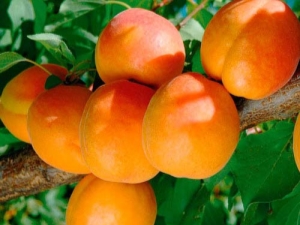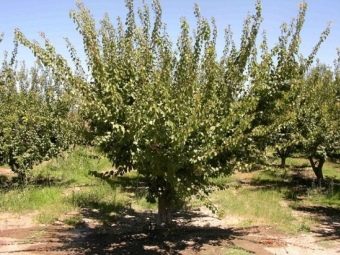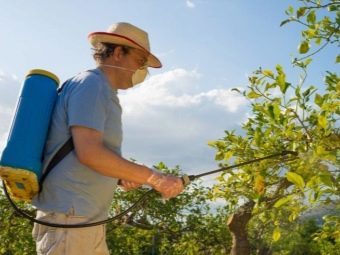Apricot "Triumph of the North": description of the variety and nuances of agricultural engineering

Fruit trees that will grow and produce a good harvest in the northern regions are always in demand. That is why a lot of attention is paid to the cultivation of such cultures. Among the brightest representatives of such varieties is the apricot "Triumph of the North", which is notable for its juicy fruits and unique qualities.
Appearance history
Apricot is a seasonal fruit that everyone loves. The fruit tree itself is very unpretentious in care, the fruits have unique taste qualities, in addition, the adult culture pleases gardeners with a high yield. Since apricot is a heat-loving tree, it was not possible to grow fruit in cold regions before. However, in recent decades, many varieties that have acquired frost resistance have been developed, including the Victory of the North, or, as it is also called, the Triumph of the North.
The colossal work of breeders allowed the residents of the northern and temperate regions to grow apricots in their summer cottages. Therefore, initially the southern plant greatly expanded the territory of its existence.
Today, fruit trees growing in central Russia allow large harvests to be harvested, which means that such qualities as endurance with respect to external factors and good fruit productivity have become inherent in the cultivated culture. In addition, according to reviews of gardeners, trees stand out by their external attractiveness, which makes it possible to plant apricot not only for picking fruit, but also as a decorative component of the decoration of the local area or summer cottage.
"Triumph of the North" is the result of serious breeding work. The variety was bred by crossing two types of apricot. The tree is a hybrid of the "Krasnoshchekogo southern" apricot, which is characterized by endurance and yield, as well as the Northern Early Trans-Baikal apricot. This plant tolerates not only heat, but also negative air temperatures.
A successful experiment on crossing was carried out by an experienced and widely known breeder Venyaminov A.N. The works were carried out in the Central Chernozem region, therefore it is considered to be the birthplace of a fruit tree. In addition to resistance to the harsh climate, when the temperature can drop to -33 degrees, the "Triumph of the North" perfectly survives in hot climates, and also withstands sharp fluctuations in weather conditions.
Characteristic
The tree has a rather large size, so the hybrid belongs to tall plants. The height of an adult tree can reach four meters and be with a spreading crown. Fruits have a mass of about 40 grams, yellow on the outside with a small pinkish in the flesh. In its sweetness, the fruits are slightly inferior to ordinary apricots and have a sweet-sour taste. However, for cooking compotes, jams and jam, the fruit will be an excellent option.
The life span of a hybrid on average is about 20-25 years, but thanks to competent care for the culture, it can be almost doubled. In some cases, this is not entirely justified, since a healthy adult tree takes up quite a lot of space on the site, and the yield index will decline with time.
Apricots ripen at the end of July, but the ripening period of fruits can be in early-mid-August, because the growth of fruits is directly affected by the number of warm and sunny days, which in some regions, for example, in the Moscow region, may differ from year to year. As the hybrid grows, the amount of the harvested crop increases. Individual cultures can produce about 50-60 kilograms. The peak yield is at the decade of the age of the tree.
Although the average weight of an apricot is 40 grams, some fruits can reach 60 grams. During the fruitful period, a lot of ovaries are formed, as a result of which the fruit may decrease in size.
"Triumph of the North" has fruits of the same shape as an ordinary variety. As for the shade, depending on the location of the fruit relative to the sun, it may have a characteristic “blush” and skin from pale pink to rich orange.
Some connoisseurs claim that the fruit has an unobtrusive almond flavor. The nucleus of the bone can also be eaten. In the confectionery industry, the bones of the hybrid are used in brewing creams, they are added as a filling in sweets. As for dairy products, apricot seeds are necessary for the production of certain dairy products, in particular, yoghurts.
Among the distinctive features of the variety are the following features:
- self-pollination - this suggests that pollinating neighbors are not needed for the growth and development of a culture;
- precociousness - as a rule, the tree gives a good harvest for about 5 year of life;
- edibility of the nucleus of the fetus;
- resistance to temperature fluctuations;
- long life expectancy of the variety;
- disease resistance;
- strong attachment of the fruit to the branches, which makes it possible to regulate the harvest to fit your needs;
- resistance to negative temperatures - wood withstands temperatures up to -33-35 degrees, kidneys - up to -28.
The minus varieties "Triumph of the North" should include the following qualities of a hybrid:
- fructification instability - rich harvests are replaced by periods when the tree produces almost no fruits;
- earlier flowering that in some regions may fall on the spring frosts;
- The height of an adult tree can make it difficult to care for.
Planting and growing
The apricot variety "Triumph of the North" is a self-pollinating crop, which means that it does not need other apricots growing nearby for the development of the fruit. This quality is important for owners of small garden plots.
The hybrid was derived taking into account the specific climate of the Russian regions, in which the arrival of cold weather is in no way tied to the calendar. Therefore, the most favorable time for planting is April or May. By that time, the seedling can already be safely planted in open ground, since the soil has already warmed up to the optimum values for the designated period, and the likelihood of sudden cold spells will be minimal.
By choosing a plant for planting should be approached carefully. Experts recommend planting trees, which at that time will be about 1-2 years. One-year-old apricot will be a fifty-centimeter branch, and the biennial plant will already have several side shoots. Careful attention should be paid to the root system - in a hybrid, the presence of fibrous roots is mandatory.
The important moment will be the fact on which tree the hybrid was grafted. Cherries will reward the plant with good disease resistance, plum provide resistance to cold.
Regarding the choice of landing site, in this case it is worth remembering that the “Triumph of the North”, like any other tree, loves the sun and warmth. On the shady side, the fruit may not ripen at all. It is best to take care of additional protection for the tree from the north, as a barrier can act as a natural or artificial barrier.
A self-fertile hybrid needs a primer that will pass moisture and air well. Therefore, peat soil for apricot will not work. The black soil will slow down the fruiting of the tree, and the sandy earth will accelerate aging. The best option would be loam. The acidity of the soil should not exceed 6-7 pH. Groundwater should lie lower than 2 meters, and if it is not possible to find such a place, it is necessary to form a hill for planting.
Planning to plant a plant in the spring, in the fall you need to do the preparation of the pit.The diameter and depth of it should be about 70 cm with the obligatory laying of drainage; crushed stone and small shards of clay should be used as raw material for such works.
The top layer of the pit is mixed with peat, sand and clay, fertilizers are added and poured onto the bottom, after which the formed mound is covered with a material that does not let the water in, leaving it in this form until the planting.
Step-by-step description of planting:
- Before planting the hybrid, the roots of the seedling are soaked in warm water with the addition of potassium permanganate and a biostimulator for at least 15 hours. Foliage with branches must be removed.
- Before planting, the roots should be cut by a third and moistened in a mixture of clay and manure, then let them dry.
- About 20 liters of water are poured into the wood pit. further apricot is placed in the center. If the seedling was purchased in a container, it should be planted together with the earth clod from the container.
- The pit must be filled in parts, carefully tamping the ground. During planting, it is worthwhile to control the level of the location of the root collar of the crop; it should be above the ground at a distance of at least 5 centimeters.
- After planting, the ground will drain a little. Already with the tree you need to water it again. This will require about 20 liters of water.
- After the water finally goes deep, it is necessary to mulch the apricot. To do this, use fresh grass, humus and peat.
- At last, the sapling is tied to the support, after which, in the presence of lateral shoots, they are pruned. Central need to trim at рез.
"Triumph of the North" - quite demanding plant in terms of care. Good watering is very important for the tree, because even despite the resistance of the variety to drought, it is important for it that the soil contains moisture. Regular watering at the end of spring will ensure a good harvest in the future. The watering itself is carried out not at the root, but through special annular grooves around the tree. On a young plant, you need about 20 liters per lap; an adult hybrid needs twice as much moisture.
With the arrival of autumn, watering is gradually reduced. This is necessary so that the apricot can prepare for cooling.
The fertilizer in the hole before planting should be enough for two seasons. Therefore, the introduction of additives should be carried out only in the third year after planting.
In the spring, any crop needs nitrogen, which allows you to build up a green mass, but this variety is very sensitive to this element, so you should enter the dressing carefully. The feeding procedure is divided into three stages:
- the first time fertilizer is carried out before the tree starts to bloom;
- the second time nitrogen is introduced after flowering;
- the final feeding is carried out after the fruit ovaries have subsided.
Chicken manure before the introduction is mixed with compost or peat in a ratio of 1: 2. Once every 3 years in spring, the soil is fertilized with humus or manure.
During the period of fruit ripening, Triumph Severny needs phosphorus and potassium. Fertilizers are sold in finished form, wood ash can be an alternative.
In the autumn, after collecting the last apricots, the final fertilizing of the tree with fertilizers is performed. Experts recommend the use of complex drugs, but from the introduction of nitrogen should be abandoned.
Not very healthy plants should be sprayed with a special composition for fruit crops, for example, "Ideal", "Good Power". By folk methods of strengthening should be attributed to watering infusion of dandelion leaves or nettle.
In the course of growing apricot portions of organic matter should be increased. A special feature of this variety is the need not only in store supplements for growth and development, but also in other trace elements. The tree signals the lack of a particular substance by changing the state of the foliage and shoots.
Regular pruning is one of the main tasks for tree care, and besides, since apricot itself cannot get rid of excess ovaries, it needs help. The first pruning is carried out during planting the seedling. With the onset of the next season you need to deal with the formation of the crown of the plant. The most common variant consists of 3 or 4 tiers, on average, 5 skeletal branches in each of them. The distance between them should be about 50 centimeters. Over the last tier of the central escape is pruned. The formation of the correct crown can take about 3 years.
In addition to the works described above, the tree requires sanitary pruning. It is necessary to monitor the condition of the branches - dried, affected by pests or diseases should be removed.
With age, the tree harvest mainly formed on the upper branches, which greatly complicates the collection of fruits. To facilitate the work itself, it is worth performing a culture rejuvenation. The process consists of the following activities:
- two lower tiers of side branches are pruned in spring;
- shoots from the trunk, located at a distance of half a meter from the ground, are removed;
- the tip is cut an average of 30 centimeters.
Despite the fact that this variety is considered the most resistant to negative temperatures, it still needs some preparation for winter. In order to save the tree, its trunk and lower branches are treated with slaked lime.
For 2 kilograms of powder, 10 liters of water will be needed; as an additional substance, sometimes copper sulfate or office glue is added to the solution.
After processing, the tree is wrapped with any material that will not restrict the access of air to the plant. Young trees simply cover the cardboard box with sawdust.
Pristvolny circle is filled with humus for the winter. When snow falls, a snowdrift should be made around it.
Threat Protection
With proper care, the tree practically does not suffer from diseases, in addition, it quickly returns to normal after attacks of pests. That is why special attention should be paid to preventive measures. These include the following work:
- weeding the circle near the tree;
- cleaning dry leaves, windfalls and debris;
- loosening the soil;
- removal of shoots or fruits on which signs of the disease were observed;
- cleaning dead bark and whitewashing the trunk;
- planting around a tree of garlic, calendula or spicy herbs to repel insect pests.
Among the most serious diseases for apricot should be distinguished monilioz and klyasterosporioz. The first disease signals the rot of the fetus, it becomes brown in color, and fungal spores appear on the skin. To prevent the disease, it is necessary to monitor the purity of the tree circle. Whitewashing the trunk in the fall also refers to preventive measures.
Plant treatment is carried out by spraying the plant Bordeaux liquid, in addition, there are special preparations, for example, "Horus". They are processed apricot during flowering.
Klesterosporioz affects foliage, holes appear on it, shoots crack, gum therapy occurs. Copper sulphate and Bordeaux spraying are used for treatment.
As for insects, apricot most often suffers from plum moth, caterpillars or aphids. Pests must be removed manually, and then destroyed. Entobacterin or 0.3% solution of karbofos is used to fight.
Collection and storage
Fruits become ripe by the end of August. Collect unripe apricots are not worth it, because they do not ripen on a branch. Often there are opinions that the fruits of the "Triumph of the North" becomes richer in its taste in canned form, and the thermal effect does not affect the presence of useful trace elements.
The collection of apricots is carried out in dry weather, wet fruits from dew or rain should not be collected because they will be stored less.
They remove the fruits by hand, it is impossible to rock the tree, because not only apricots can be damaged, but also branches. After collection, they must be sorted and put in cardboard or wooden boxes. The harvest is stored at a temperature of from 0 to +2 degrees for no more than two weeks.
The most effective option for preserving fruits is drying. Dried apricots perfectly preserved in a cellulose bag in a refrigerator for up to six months. Indoors, dried fruits will remain much less, they will darken within a month and a half and will lose all useful substances.
In addition to eating fresh fruits, apricot is an excellent product for home canning. Jam, marmalade, compotes, etc. are made from it.
Gardeners tips
In order to harvest a good apricot crop, growing fruits in the middle lane, you should follow simple recommendations, as well as take into account the biological characteristics of the variety.
Experienced gardeners identify a number of rules that should guide the planting of the "Triumph of the North":
- a properly selected place for planting a tree, as well as a favorable climate will be the key to the rapid growth of culture;
- competently prepared land for a young sapling and timely planting will ensure its quick adaptation to new conditions;
- Adhering to the basic recommendations of agricultural technology and the care of crops, you can achieve a good harvest of apricots.
In the next video you will find an overview of the best varieties of apricots, including the "Triumph of the North".









































